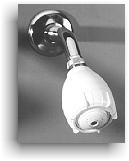 | Other actions may require a small investment of time and money. Installing low-flow showerheads and faucet aerators can save significant amounts of hot water. Low-flow showerheads can reduce hot-water consumption for bathing by 30%, yet still provide a strong, invigorating spray. Faucet aerators, when applied in commercial and multifamily buildings where water is constantly circulated, can also reduce water-heating energy consumption. Older showerheads deliver 4 to 5 gallons (15.1 to 18.9 liters) of water per minute. However, the Energy Policy Act of 1992 sets maximum water flow rates at 2.5 gallons (9.5 liters) per minute at a standard residential water pressure of 80 pounds per square inch (552 kilopascals). |
A quick test can help you determine if your shower is a good candidate for a showerhead replacement. Turn on the shower to the normal pressure you use, hold a bucket that has been marked in gallon increments under the spray, and time how many seconds it takes to fill the bucket to the 1-gallon (3.8-liter) mark. If it takes less than 20 seconds, you could benefit from a low-flow showerhead. A top-quality, low-flow showerhead will cost $10 to $20 and pay for itself in energy saved within 4 months. Lower quality showerheads may simply restrict water flow, which often results in poor performance.
Because of the different uses of bathroom and kitchen faucets, you may need to have different water flow rates in each location. For bathroom faucets, aerators that deliver 0.5 to 1 gallon (1.9 to 3.8 liters) of water per minute may be sufficient. Kitchen faucets may require a higher flow rate of 2 to 4 gallons (7.6 to 15.1 liters) per minute if you regularly fill the sink for washing dishes. On the other hand, if you tend to let the water run when washing dishes, the lower flow rate of 0.5 to 1 gallon per minute may be more appropriate. Some aerators come with shut-off valves that allow you to stop the flow of water without affecting the temperature.
|
|
|
| Copyright © Aclara Technologies LLC. All Rights Reserved. | |